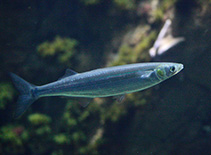| Family: |
Atherinopsidae (Neotropical silversides), subfamily: Atherinopsinae |
| Max. size: |
45 cm TL (male/unsexed); max. reported age: 11 years |
| Environment: |
pelagic-neritic; marine; depth range - 30 m |
| Distribution: |
Eastern Pacific: Yaquina Bay in Oregon, USA to southwestern coast of Baja California, Mexico. |
| Diagnosis: |
Dorsal spines (total): 6-10; Dorsal soft rays (total): 11-14; Anal spines: 1-1; Anal soft rays: 21-26; Vertebrae: 50-54. Branchiostegal rays: 5-6 (Ref. 36497). |
| Biology: |
Adults inhabit inshore areas, including bays (Ref. 2850). Form schools (Ref. 2850). Demersal spawners in nearshore habitats (Ref. 56049). Oviparous, with planktonic, primarily neustonic larvae (Ref. 36497). Eggs are attached to one another by spawning substrate via adhesive filaments (Ref. 36497). Sold fresh (Ref. 2850). |
| IUCN Red List Status: |
Least Concern (LC); Date assessed: 01 May 2008 Ref. (130435)
|
| Threat to humans: |
harmless |
Source and more info: www.fishbase.org. For personal, classroom, and other internal use only. Not for publication.

